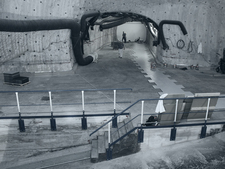Time schedule for drilling into Asse
BfS presents schedule for drilling into chamber 7 on the basis of the licence granted by the Lower Saxon Environment Ministry
The Federal Office for Radiation Protection (BfS) has set up a comprehensive time schedule for drilling into the first emplacement chamber of the Asse repository. This schedule takes into consideration the time that is necessary for complying with the licensing requirements of the Lower Saxon Environment Ministry (NMU). On 21 April 2011 the NMU issued its licence including 32 requirements. The BfS needs to fulfil these requirements before the first emplacement chamber of the Asse mine may be drilled into. "On the basis of these requirements, we have set up a time schedule consisting of about 850 work steps
", a BfS spokesman said. If everything goes according to plan, drilling works can start at the beginning of November.
At that time one will at first start the drilling works in front of emplacement chamber 7 in a depth of 750 m. In 1977 and 1978 more than 3,000 drums coated in concrete and around 1,200 steel drums containing low-level radioactive waste were emplaced into this chamber. By drilling into the emplacement chamber the BfS wants to find out, among others, if explosive or radioactive gases have generated there or if there are contaminated solutions. Besides, the BfS anticipates getting knowledge on how stable the emplacement chambers are and in what state the rock salt is the chamber was backfilled with after the waste had been emplaced. It is expected that the major part of the drums is no more intact due to rock pressure.

![]() Staff of the Asse-GmbH lay decontaminable floor plates in front of emplacement chamber 7 to prepare drilling works
Staff of the Asse-GmbH lay decontaminable floor plates in front of emplacement chamber 7 to prepare drilling works
Currently staff of the Asse-GmbH are laying decontaminable floor plates in front of chamber 7. Only after experts have cleared the floor plates may the drilling device be set up with all safety installations. Measuring devices are also being set up to ensure radiation protection. Furthermore, control devices used for monitoring the exhaust air from the field of work need to be installed and tested. Prior to the first drilling all devices need again to be cleared by experts and regulatory authorities. In parallel the drilling crew is trained again at the installed devices. "The safety of staff and residents is of utmost priority
", the BfS spokesman said.
The first step of the drilling works is to set in concrete a so-called stand pipe into the bore hole. The tightness of the piping also needs to be confirmed by experts. Only then can a so-called preventer be mounted to the stand pipe. This device prevents that gases or liquids possibly existing in the chamber can reach the mine in an uncontrolled way after one has drilled into the chamber. The purpose of the first drilling, which is 20 to 30 metres long, is to hit a cavity which is assumed to be in emplacement chamber 7. Following this, one intends to insert camera probes through the bore hole into the chamber and to take air samples. With the help of these samples the radiological and chemical composition of the chamber atmosphere will be examined.
To close the Asse mine safely the BfS has compared different decommissioning options. In January 2010 it was determined in co-ordination with the Federal Environment Ministry that according to the present state of knowledge the retrieval of all waste was the best option for the further handling of the Asse mine. All institutions involved agreed that, for retrieving the waste, more boundary conditions needed to be examined in a trial phase, to be able to guarantee the safety of the population and the staff when using this approach, which has been unprecedented so far. To clarify open questions the BfS decided on carrying out a three-stage trial phase (fact finding) prior to actually retrieving the waste. For this purpose, two of the 13 emplacement chambers are to be driven into initially. At the end of October 2010 the BfS submitted to the NMU the application for the licence required for drilling into the first emplacement chamber according to the Atomic Energy Act.

